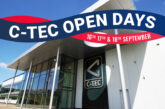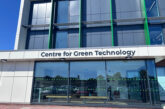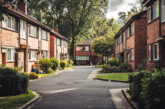
When installing downlights into fire rated ceilings, make sure that you follow the latest NHBC guidance. The team at Tenmat explains why.
Did you know that there is new NHBC (National House Building Council) guidance on recessed light fittings?
When installing downlights in houses and dwellings, special attention needs to be given to the critical fire protection of these downlights as they represent an open path for the passage of fire and smoke.
Recent changes in construction methods from solid timber joists to light weight joists, which are more fragile when exposed to fire, has made the fire protection of modern ceiling constructions much more critical to avoid premature collapse and vertical fire spread.
The correct fire testing of downlight products is a complex, expensive and lengthy process which can often be misunderstood within the lighting industry. This has led to many non-compliant products needing to be removed from ceilings, resulting in wasted time and money.
The latest NHBC guidance requires testing on each joist type to reflect the actual construction in which the product is being used, especially for joist types for 30 minute ceilings which are most likely to be either metal web joists or I-beam joists. Fire test data is only acceptable when it is from a full scale loaded test and is supplied from a UKAS approved test house.

The correct choice of protection
Lighting and LED technology is moving at a fast pace, and end-users are often changing their light fittings on a regular basis to improve energy efficiency and/or light output, meaning that products rapidly become obsolete.
The constant changing and updating of light fittings can lead to mistakes being made when it comes to the choice of product to provide the correct level of fire protection for that particular ceiling construction.
Fitting Tenmat Downlight Covers solves this problem as, once installed, the product remains in the ceiling no matter what light fitting is installed or how often it is changed, providing 100% fire protection all of the time.
The Tenmat solution provides constant fire protection independently of the light fitting, which allows customers a much greater choice of fitting. The hoods don’t have to be fire rated and so will also save costs with every subsequent lighting change, as well as providing complete peace of mind.
It’s important that downlight covers are also compatible with modern LED light fittings and don’t overheat them, which will reduce the life of the lamp. Tenmat’s products have been tested to the most onerous BS EN60598 thermal build-up test and are approved for all fittings up to 50W.
A downlight cover only performs properly when it is correctly fitted. Tenmat covers are fully pre-formed and are simply passed through the hole and clipped in place, ensuring they’re always quickly and correctly installed.
In addition to providing fire protection, the covers also reinstate the acoustic performance of a ceiling, which is lost when ceiling penetrations are made. They’ve also been tested by BRE Acoustics Laboratory to the BS EN ISO 140 parts 5 and 6 standard and show that full acoustic performance is restored by the covers.
Tenmat’s Downlight Covers are backed by an impressive array of testing and approvals obtained over the past twenty years, with the FF109 Downlight Cover range fully tested in metal web joists, I-beam and solid timber joists.
Get more details by clicking here








